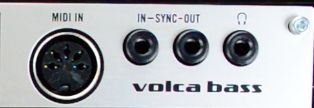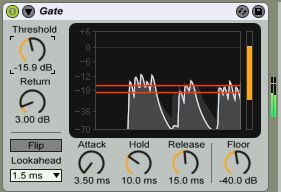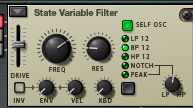Synthesizers bring not only huge, impressive orchestrations of sonic delight, but they also bring flexibility, and choices to the seasoned and budding producers. However, like all instruments, there are some big areas where synthesizers can be misused in a mix, if you’re not careful. Let’s go over a few areas where synths can work against your mix!
1. Too Much Filter Resonance
Filter sweeping is a classic tradition in EDM, Trance, and Techno of all types, but even though making those filters scream sounds amazing for a few measures, the loud whistling that occurs when the filter is being overdriven can really get annoying after a while. Definitely filter sweep, and don’t be afraid to overdrive, but use it sparingly, or you might get a little annoying.
2. Mixing Synth Basses On Heaphones
Synthesizers are capable of hitting some seriously low frequencies. While that bass that you’re jamming might sound perfect through headphones, you might notice some additional low end that wasn’t there before when you play it back over speakers because your headphones don’t have a wide enough frequency range. Mix through speakers, especially when using sub-basses!
3. Using the Same Patches Non-Stop

A synthesizer is like any instrument, if you over feature a specific patch, you might bore your listener. Granted, bass patches can play throughout a song, as they maintain a sonic foundation. Leads, pads, plucks and strings, however, when played throughout the whole song, with no breaks, can give your listener the impression of repetition and induce boredom. Try reserving some patches/tracks for verses, some for choruses, and then leave some patches, like plucks, to be sprinkled lightly throughout your track.
4. Stacking Synth Basses
Grooving with a couple of bass synth patches might sound amazing over headphones, but as soon as you hear the two competing patches playing on top of one another in the same frequency range, over club speakers, or even studio monitors, you may hear nothing but bass. Try a pluck, or a lead style patch, instead of a second bass. This will keep your bass in the right place, while still giving you some cool mid-range accompaniment.
5. Forgetting to Filter Those Big Pads!
Synths can create giant, thick string sections, resonant sweeps, choirs and more. But, keep in mind that the phatter the pad, the more room in takes up in your mix. If you run into this, try either employing a band pass filter to kill some of the high frequencies, and makes space for vocals, and roll off some low frequencies so that bass and kick have a place to sit.

6. Use More Than One Step Sequencer Pattern!
I hear a lot of demos from people who come up with some really sick step sequencer patterns. But, they forget that you can create more than one pattern! If you’re working with, for example, the Matrix, in Reason, or a hardware synth, like the Korg volca bass, don’t forget that you are able to make more than one pattern! Once you have a couple of cool patterns, try switching between a few, fairly regularly to avoid repetition.
7. Forgetting About Line Noise
Old synths and even new hardware synths will oftentimes put off a little hum/background noise that is audible, even while the synth is idle. If you’ve got one, or more synthesizer that fits this description, make sure you put a gate on this synth, so that the background is being cut out, automatically. Or, after tracking a hardware synth on a computer, go back and delete dead air, within the mix to keep it sounding clean.

8. Forgetting to Save Patches!
Spend 2 hours on a lead patch that sits perfectly? Don’t forget to save it, even if it is a software synthesizer. There is nothing more frustrating than re-opening a song, only to hear the wrong synth patch playing over your carefully created beats. Even soft synths can sometimes glitch and fail to read patch data within a song file. Save, even when you don’t think you need to!
9. Use Sync As Much as You Can!
MIDI and Control Voltages both give the producer extremely precise synchronization between multiple devices. Running multiple patterns sequencers without sync can sound really messy, even when you’ve got someone riding the tempo knob. It can be frustrating to set up MIDI sync over a DAW, but it is absolutely necessary! If this is not possible due to limited MIDI ports, try getting a MIDI patch bay. These devices can send sync to multiple synths, samplers and drum machines, at once, as well as giving you the ability to switch between and play multiple devices.
10. Adding Too Many Instruments!
Its’ hard to believe, but having too many instruments in one song can sound like a huge mess and make playing back your song a nightmare, as well as giving you a huge bear to mix. DAWs can supply many, many software synthesizers, but the more synth patches you add, the more complicated it gets to mix. Try copying sequence data of some parts to other soft synths in your mix with a similar sound and frequency range, and then disable the soft synths that you don’t need. This will free up processing power of your CPU, take some load off of your hardware synths and make the song, itself, much easier to mix!
11. Forgetting the Song Underneath All the Electronics
Nothing leaves bigger statement than silence. And, mixes that incorporate musical areas of sparse instrumentation, and silence, through breaks tend to really capture the audiences attention. The general, unspoken rule is the lighter the arrangement, the more intimate the song comes across. It’s always tempting to show off what your hardware can do, but never at the expense of the song. Keep your arrangements light, and give space for your vocals!

Conclusion
With great power comes great responsibility, especially when it comes to the song, itself. And, that’s the main aspect of a producers job—producing the best possible version of a song, regardless of the instrument being used. Synthesizers are amazing tools for song composition, song production, and dance floor awesomeness, but the song always comes first! Be thoughtful in your arrangements and your synth usage, and your songs will shine!



 © 2024 Ask.Audio
A NonLinear Educating Company
© 2024 Ask.Audio
A NonLinear Educating Company
Discussion
#2 is not necessarily true with the right headphones — in fact due to proximity and tightness, you may actually reap the rewards of more accurate bass in headphones. In my case, it's a necessity due to hearing impairment with speaker positioning. I know this is atypical but it's my great comfort.
The sub-bass on the now-discontinued-but-too-awesome Sony MDR-XB700 is phenomenal and generous without being flabby. For anyone skeptical, I implore you to check out a pair for yourself.
Also re: #11, yeah, technical skills shouldn't overshadow the song itself. Contrasts within a track can be very powerful — such as a light/minimal intro leading up to an intense and dense climax. Another simple thing to do is, if your mix is too crowded and you don't want to simply disable certain tracks, well, just tremendously soften them. It's intriguing how these "shadows" still have a presence in the final mix. Even if they're barely heard... they can still be felt!
Want to join the discussion?
Create an account or login to get started!